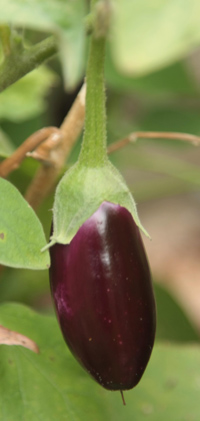
- Starting Seeds, Soil Preparation, Culture and Fertilization
- Harvesting
- Storing and Using
- Problems
- Varieties
Eggplant (Solanum melongena) was introduced into the United States by Thomas Jefferson, who brought this heat-loving member of the Solanaceus family from Europe. While the original eggplants actually looked white, similar to chicken eggs, they now come in many shapes, sizes and colors. Eggplant can be grown in all Georgia gardens, and with some care, the harvest can be quite prolific. They can also be grown in containers for their ornamental and decorative features.
Starting Seeds, Soil Preparation, Culture and Fertilization
Start the seeds indoors about six to eight weeks before the last frost. In south Georgia, this will be about the third week of February. In north Georgia, this will be the last week of March. Cover the seeds very lightly with the soil and keep them in a warm place with good light. Supplemental light may be required to promote sturdy growth and prevent plants from becoming leggy. Set up lights 6 inches above the plants, and keep them on for about 14 hours a day. Water the soil using fine mist to keep the plants moist. Harden the plants off before transplanting them into your garden. This can be done by leaving them outside for two or three days, but bringing them back inside each night. On the fourth day leave them outside for 24 hours.

Purchased transplants from a local garden center can also be used. Eggplants thrive in warm soils, so wait to purchase plants until the danger of frost has passed and the weather is consistently sunny and warm. The soil temperature should reach 65-70°F before planting the transplants in the garden. Eggplants need a well-drained soil that receives eight to 10 hours of sunlight per day.
For proper fertilization, a soil test (available through the county Extension office) is always recommended. The soil pH should be between 6.0 and 7.0 for best growth. In the absence of a soil test, a complete fertilizer such as 10-10-10 or 13-13-13 can be applied at the rate of 3 pounds per 100 square feet of garden. Spade or till the soil to a depth of at least 6 to 8 inches. Adding organic matter in the form of topsoil, compost or a bagged amendment and incorporating it into the native soil can improve results. After amending and tilling, level the soil with a rake.
Eggplants can also be planted in raised beds. Plant eggplants in a row, spacing them 18 inches apart, with at least 30 inches in between rows.
Once the plants mature, they might need some support. Tomato cages can be used for this purpose. Mulch the plants with weed-free grass clippings, straw or wood chips to prevent weeds from growing and to conserve water. Water as needed to a depth of 6 inches with drip irrigation when possible. Eggplants require between 1 to 2 inches of water per week for best production.

Harvesting
Eggplants will be ready for harvest, depending on the variety, in 64 to 80 days. Harvest eggplants when they develop a shiny skin and feel firm when squeezed. Cut the fruit with a sharp knife or pruners. Never twist the fruit to break it from the stem as this might limit future crop production. Eggplants will continue to produce fruit throughout the summer and fall until the first frost.
Storing and Using
Eggplant is highly perishable and should be used soon after harvesting. Store eggplants in a paper bag in the coolest place in the house for up to two days. In the refrigerator, eggplants will store for about five days. Eggplants can also be stored in the freezer if they are skinned, sliced and blanched before freezing.
Problems
Eggplants are susceptible to flea beetles, which make holes in the leaves the size of a pin and cause serious damage. To minimize insect damage, keep a close eye on the plant and use an approved organic or chemical pesticide when necessary.
Varieties
| White varieties | Purple varieties |
| Ghostbuster – matures in 80 days after planting | Black Beauty – matures in 60 days after planting |
| Santana – matures in 80 days after planting | Classic – matures approximately 76 days after planting |
| Snowy – matures in 70 days after planting | Epic – matures in 64 days after planting |
| Casper – matures in 70 days after planting |
Status and Revision History
Published on Apr 30, 2013
Published with Full Review on Mar 28, 2017
Published with Full Review on Jun 21, 2022


























































